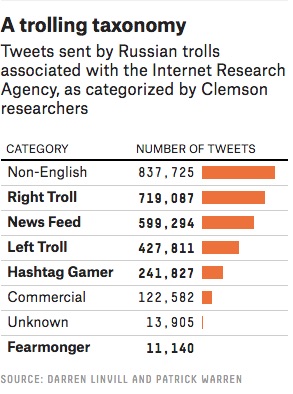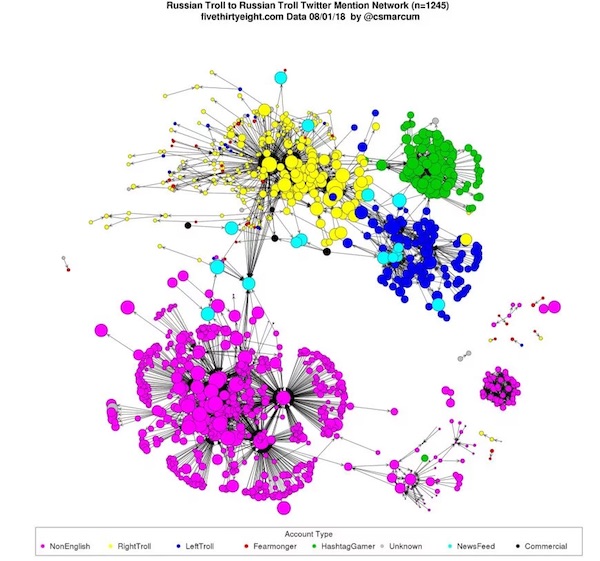How trolls divide America and what you can do about it
It’s clear that Russians interfered in our elections. But their objective was not primarily to elect Donald Trump — it was to make us hate each other. And they’re succeeding.
New information on Russian troll activity is now available, including a corpus of 3 million tweets from Russian trolls who were part of a foreign influence group called the Internet Research Agency. Fivethirtyeight.com made this data set, from Clemson professors Darren Linvill and Patrick Warren, available for anyone to analyze.
The obvious caricature of the activity of such trolls is that they are out to boost the activities of Russia-loving President Donald Trump. But that’s a misconception. The Clemson professors’ analysis classifies the tweets into categories including “Right Troll,” “Left Troll,” and “Hashtag Gamer.” As described on fivethirtyeight.com:
Right Trolls behave like “bread-and-butter MAGA Americans, only all they do is talk about politics all day long,” Linvill said. Left Trolls often adopt the personae of Black Lives Matter activists, typically expressing support for Bernie Sanders and derision for Hillary Clinton, along with “clearly trying to divide the Democratic Party and lower voter turnout.
Here’s a breakdown of the tweets that the trolls in different categories made:

Hashtag gamers have fun with hashtag games like #OneLetterOffMovies, but thrown in some irrelevant and divisive political posts on these same hashtags. And Fearmongers spread fake stories about stuff like salmonella-contaminated turkeys at Thanksgiving.
Keep in mind that these 3 million tweets are only from the accounts identified most recently, there are likely ten times as many from trolls that were taken down earlier, or those that are still operating.
Data scientists have already begun analyzing these tweets. For example, here’s a chart from Christopher Marcum that shows the connections between the different categories of trolls through mentions and retweets:

The diversity and interconnectedness of these groups reveals how wrong the “trolls for Trump” narrative is. The purpose of the trolls was not to get Trump elected (or at least, not only to get Trump elected). I’m certain if you asked the people running these troll farms if they could change the outcome of the 2016 election, they would have said “That’s a long shot,” following the best analysis of the likes of Nate Cohn in the New York Times and Nate Silver at fivethirtyeight.com.
What trolls want
According to an indictment that followed the Mueller investigation of Russian election interference, “officials at . . . the Internet Research Agency, described their work as ‘information warfare against the United States’ and their goal as ‘spreading distrust toward the candidates and the political system.’ ”
What the trolls actually want is much more basic: they want to destroy public trust in every possible institution that makes America strong. For example, they want to:
- Create divisions in the Republican party between traditional conservatives and nationalists like Donald Trump.
- Create divisions in the Democratic party between socialist/left-leaning candidates like Jill Stein and Bernie Sanders, and more moderate candidates like Hillary Clinton and Joe Biden.
- Create distrust in government law enforcement institutions like the FBI.
- Undermine alliances like NATO and the strong ties that the US has with Canada and the UK.
- Undermine trust in mainstream media outlets.
- Undermine trust in scientific consensus that backs such ideas as the efficacy of vaccines and the reality of global warming.
- Support the activities of fringe conspiracy mongers like Alex Jones.
- “Nationalize” elections, destroying cross-party support for moderate, effective local and state leaders like Massachusetts Republican Governor Charlie Baker and California Democratic Governor Jerry Brown.
- Inflate the importance of divisive issues like abortion, immigration, and gun control compared to issues where there is broad agreement, like infrastructure spending and restricting pollution.
Read that list and you’ll recognize that the trolls are well on their way to succeeding in their goals. (You may also notice that all of these goals seem to align with the activities and tweets of President Trump.)
It reminds me of the plot of the sixties Mel Brooks/Buck Henry TV series “Get Smart,” where the American agency “Control” does battle with an international organization of evil called “KAOS,” filled with people with German and Russian accents. As in Get Smart, the forces of chaos are threatening to overwhelm the sanity of control.
In Get Smart, Control always won. But the general population wasn’t sucked into the influence of chaos. In 2018, chaos is doing just fine in persuading average citizens on Twitter, Facebook and Instagram to boost the most divisive of issues, believe in and share fake news, and hate each other.
What should you do?
At Facebook and Twitter, algorithms and filters magnify extremes and differences. I believe this division is a more dangerous threat to America than any normal politician, no matter how much I disagree with that politician.
Here’s what I’m doing to fight trolls.
- Reaching out to those I disagree with, including Trump voters, to open up and maintain a dialogue. I want us to see each other as humans. I’d love to see Trump gone, but winning his voters back is crucial to restoring sanity.
- Trying to understand the forces that create division and the points on which diverse voters disagree. (The incredible op-eds of Diane Hessan in the Boston Globe, based on interviews with a panel of voters, are excellent for revealing those sources of common ground.)
- Carefully checking what I share on social media; calling out fakes, including those that appear to support my own point of view.
- Supporting thoughtful analysis and spreading mainstream media reporting, including articles from those I disagree with. (Here’s a great article on economics in the conservative journal National Review, for example.)
- Subscribing to and paying for media content from hard-working reporters and news organizations.
- Searching for and supporting politicians who I believe can unify the country and bring us back together.
Some of these positions aren’t popular. But if you continue to lurch toward division, look to your left and to your right — and to your Twitter and Facebook feed. You may find that the people whose opinions you’re sharing aren’t people, they’re foreign agents trying to manipulate you.
I’ll remain skeptical and biased toward unity. I think it’s the only way to save the country I love.
Parting shot: here’s a video that vividly and accurately depicts what’s actually happening with Russian trolls.
Great explanation, thanks!
Thank you for this! I am sharing with everyone I know. Kind of scary!
Constructive essay, Josh (adding to my own WOBS Top 10 list). Even before reading, I’d dedicated the balance of my years and public involvement to the demonization of labels and invitation to ideas. It’s proven much harder than I’d imagined – even with friends and family.
Moving Americans to informed, non-dual thinking requires patience and sensitivity; it hasn’t helped that our last three presidents proved themselves ineffective salespersons. Our current primary system assures much of the same. Are Americans ready for unifying third party?